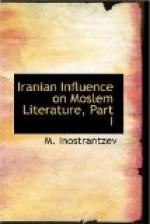Under different circumstances but with considerable significance for the Persian national ideals lay the Southern province of Fars. Here with tenacious insistence survived not only national but also political traditions of ancient Sasanian Persia. Here was the centre of a government and from here started fresh dynasties. After the Arab conquest this province came into much more intimate connection with the Khalifate, than, for instance, Khorasan. But Persian elements were favoured by its geographical position,—the mountainous character of its situation and the consequent difficulty of access by the invaders. We already produced above the information of the Arab geographers of the tenth century regarding the abundance of fire-temples and castles in Fars. They relate that there was no village or hamlet of this province in which there was no fire-temple. Residence was taken up in strong castles by the native aristocrats whose ideals were rooted in the Sasanian epoch. Just in these geographers, Istakhri and Ibn Hauqal, is to be found information of unusual importance, so far as we can judge, regarding the conservation of the Parsi tradition in Fars These authors have been up to now not only not appreciated but their significance for our question has not yet been adequately recognised.
Istakhri and Ibn Hauqal enumerating the castles of Fars declare as follows regarding the castle of Shiz:[1]
“The castle of Shiz is situated in the district of Arrajana. There live fire-worshippers[2] who know Persia and her past. Here they study. This castle is very strong.”
[Footnote 1: Istakhri, p. 118, 2-4; Ibn Hauqal, p, 180, 1-2.]
[Footnote 2: In the text occurs the Persian word badgozar, that is to say, the rhapsodists, the relators of the national traditions; on this word see B.G.A. III, pp. 182-83, and Vuller’s Lexicon Persico-Latinum S.V. For a parallel to the archives of the Achamenide empire see F. Justi, Ein Tag aus den Leben des konigs Darius.]
Further we read the following in Istakhri (page 150, 14-17):—
“In the district of Sabur on the mountain there are likenesses of all the noteworthy Persian kings and grandees, of illustrious preservers of fire, high mobeds and others. Their portraits, their acts and narratives about them are successively recorded in volumes. With particular care are preserved these volumes by the people living in a locality in the district of Arrajan called the castle of Shiz.”
From this information we learn that in one of the castles of Fars down to the tenth century there were preserved manuscripts written probably in the Pahlavi language containing narratives from Persian history and illustrated with, portraits after the style of the Sasanian reliefs to be found in the rocks in the district of Sabur.[1] This strong mountain fastness was probably little accessible to the Arabs and afforded an asylum to the mobeds, dehkans and others interested in the past of their country.




